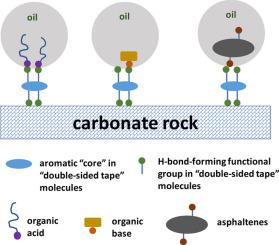Our official English website, www.x-mol.net, welcomes your feedback! (Note: you will need to create a separate account there.)
Identification of organic species with “double-sided tape” characteristics on the surface of carbonate reservoir rock
Fuel ( IF 7.4 ) Pub Date : 2021-03-01 , DOI: 10.1016/j.fuel.2020.119627 Nathalia Tessarolo , Nan Wang , Chrissie Wicking , Ian Collins , Kevin Webb , John Couves , Jonathan Crouch , Colm Durkan , Huang Zeng
Fuel ( IF 7.4 ) Pub Date : 2021-03-01 , DOI: 10.1016/j.fuel.2020.119627 Nathalia Tessarolo , Nan Wang , Chrissie Wicking , Ian Collins , Kevin Webb , John Couves , Jonathan Crouch , Colm Durkan , Huang Zeng

|
Abstract Carbonate reservoir rocks are normally mixed-wet or oil-wet, leading to low oil recovery efficiency using water-based oil recovery methods. It is critical to understand the molecular composition of the organic material coating the surface of carbonate reservoir rock in order to design better enhanced oil recovery (EOR) methods. Herein, we extracted organic compounds from a carbonate reservoir rock and characterized their composition using high resolution mass spectrometry (HRMS). In contrast to conventional interpretation that the mixed-wet or oil-wet nature of carbonate reservoir rocks arises from the adsorption of carboxylic acids, our results demonstrated that the organic species strongly bound to carbonate reservoir rock surface are dominated by N-containing species, including a group of “sticky molecules”. Each of these molecules can form multiple hydrogen-bonds, therefore they might act as a “double-sided tape” which binds crude oil strongly to the carbonate rock surface. Furthermore, we applied atomic force microscopy (AFM) techniques to a model mineral surface with regions of positive change and negative charge which was contacted with the crude oil produced from the formation where the rock was sampled. It was found that only the organic molecules with positive charge in the oil were adsorbed onto the mineral. This supports HRMS results which suggest that the organic materials strongly bound to the carbonate reservoir rock surface are dominated by basic N-containing molecules. Overall, these findings suggest that, beside fatty acids, these “sticky molecules” might also play an important role in controlling the wetting state of carbonate reservoir rock.
中文翻译:

碳酸盐岩储集岩表面具有“双面胶带”特征的有机物种识别
摘要 碳酸盐岩储层岩石通常是混合湿或油湿的,导致采用水基采油方法的采油效率低。为了设计更好的提高采收率 (EOR) 方法,了解覆盖碳酸盐储层岩石表面的有机材料的分子组成至关重要。在此,我们从碳酸盐岩储层中提取有机化合物,并使用高分辨率质谱 (HRMS) 表征其组成。与碳酸盐岩储集岩的混合湿性或油湿性是由羧酸的吸附引起的传统解释相反,我们的研究结果表明,与碳酸盐岩储集岩表面强结合的有机物种以含氮物种为主,包括一组“粘性分子”。这些分子中的每一个都可以形成多个氢键,因此它们可能充当“双面胶带”,将原油牢固地粘合到碳酸盐岩表面。此外,我们将原子力显微镜 (AFM) 技术应用于具有正变化和负电荷区域的模型矿物表面,该表面与从岩石取样的地层中生产的原油接触。发现只有油中带正电荷的有机分子被吸附到矿物上。这支持 HRMS 结果,该结果表明与碳酸盐储层岩石表面强结合的有机物质主要由碱性含氮分子支配。总的来说,这些发现表明,除了脂肪酸,
更新日期:2021-03-01
中文翻译:

碳酸盐岩储集岩表面具有“双面胶带”特征的有机物种识别
摘要 碳酸盐岩储层岩石通常是混合湿或油湿的,导致采用水基采油方法的采油效率低。为了设计更好的提高采收率 (EOR) 方法,了解覆盖碳酸盐储层岩石表面的有机材料的分子组成至关重要。在此,我们从碳酸盐岩储层中提取有机化合物,并使用高分辨率质谱 (HRMS) 表征其组成。与碳酸盐岩储集岩的混合湿性或油湿性是由羧酸的吸附引起的传统解释相反,我们的研究结果表明,与碳酸盐岩储集岩表面强结合的有机物种以含氮物种为主,包括一组“粘性分子”。这些分子中的每一个都可以形成多个氢键,因此它们可能充当“双面胶带”,将原油牢固地粘合到碳酸盐岩表面。此外,我们将原子力显微镜 (AFM) 技术应用于具有正变化和负电荷区域的模型矿物表面,该表面与从岩石取样的地层中生产的原油接触。发现只有油中带正电荷的有机分子被吸附到矿物上。这支持 HRMS 结果,该结果表明与碳酸盐储层岩石表面强结合的有机物质主要由碱性含氮分子支配。总的来说,这些发现表明,除了脂肪酸,



























 京公网安备 11010802027423号
京公网安备 11010802027423号